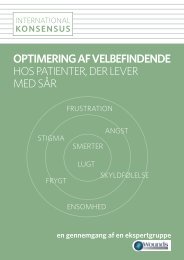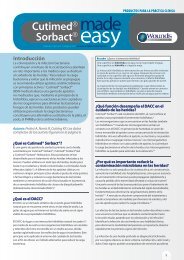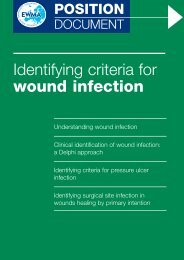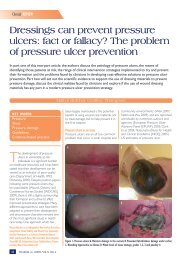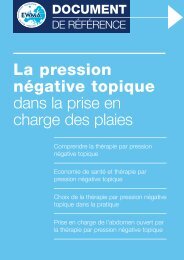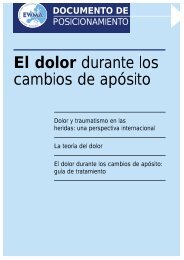leg ulcer management in patients with chronic oedema - Wounds ...
leg ulcer management in patients with chronic oedema - Wounds ...
leg ulcer management in patients with chronic oedema - Wounds ...
Create successful ePaper yourself
Turn your PDF publications into a flip-book with our unique Google optimized e-Paper software.
ReviewFigure 6. Positive Stemmer’s sign.When the muscles contract andexpand (e.g. dur<strong>in</strong>g exercise)they press aga<strong>in</strong>st the bandageand the pressure <strong>in</strong> the limbtemporarily <strong>in</strong>creases. This<strong>in</strong>creased ‘work<strong>in</strong>g’ pressurestimulates lymphatic pump<strong>in</strong>gand reabsorption of lymph(Moffatt, 2000).Management of <strong>leg</strong> <strong>ulcer</strong>sA graduated, susta<strong>in</strong>edcompression therapy istraditionally used <strong>in</strong> the<strong>management</strong> of <strong>leg</strong> <strong>ulcer</strong>s, <strong>with</strong>a wound dress<strong>in</strong>g selected asappropriate for the specificwound. A layered bandag<strong>in</strong>gsystem is used and is said tobe more effective than s<strong>in</strong>glelayer systems (Fletcher et al,1997). These systems are onlyapplied below the knee anddo not <strong>in</strong>clude the toes. Thebandages are left <strong>in</strong> situ forup to one week. The choiceof dress<strong>in</strong>g and bandag<strong>in</strong>gsystem will depend upon thepatient’s condition, assessmentand patient choice (Dowsett,2005).Management of <strong>leg</strong> <strong>ulcer</strong>sand <strong>chronic</strong> <strong>oedema</strong>: whichbandag<strong>in</strong>g system?Patients <strong>with</strong> <strong>chronic</strong> <strong>oedema</strong>and <strong>ulcer</strong>ation require a differentapproach to treatment thanthose <strong>with</strong> venous <strong>ulcer</strong>ationalone. The specific issuesassociated <strong>with</strong> manag<strong>in</strong>g thepatient <strong>with</strong> lymph<strong>oedema</strong>tous<strong>ulcer</strong>ation <strong>in</strong>clude:8Limb shape distortion8Care of sk<strong>in</strong> creases and folds8Swell<strong>in</strong>g of the toesand forefoot.These issues require a modifiedapproach to the usual venous<strong>leg</strong> <strong>ulcer</strong> bandag<strong>in</strong>g regimens(Moffatt et al, 2005).Patients <strong>with</strong> limb distortionand sk<strong>in</strong> folds or creases willrequire a more specialisedapproach to their careand, if available, work<strong>in</strong>g<strong>in</strong> conjunction <strong>with</strong> alymph<strong>oedema</strong> specialist serviceis useful. The use of padd<strong>in</strong>gor foams is needed to correctthe limb shape, pad out thesk<strong>in</strong> creases and even out thebandage shape to ensure thelimb reta<strong>in</strong>s a cyl<strong>in</strong>drical shape<strong>in</strong> order to ma<strong>in</strong>ta<strong>in</strong> the correctcompression gradient(Todd, 2000).In many cases where traditionalvenous <strong>leg</strong> <strong>ulcer</strong> bandag<strong>in</strong>g isused for <strong>patients</strong> <strong>with</strong> <strong>chronic</strong><strong>oedema</strong>, <strong>oedema</strong> of the toesand forefoot develops. Oedemaof the toes occurs when thebandages cause pressure onthe dorsum of the foot, push<strong>in</strong>gfluid down <strong>in</strong>to the toes. Wherevenous <strong>leg</strong> <strong>ulcer</strong> bandages havenot been applied far enoughdown the foot, dorsal swell<strong>in</strong>gmay occur. If the lymphatics<strong>in</strong> this area become stagnant,secondary sk<strong>in</strong> changes maytake place (Tiwari, 2003), suchas a positive Stemmer’s sign(Figure 6), thickened sk<strong>in</strong>, orpapillomatosis.It has been suggested thattraditional venous <strong>ulcer</strong>bandag<strong>in</strong>g systems used for<strong>patients</strong> <strong>with</strong> <strong>chronic</strong> <strong>oedema</strong>may result <strong>in</strong> persistent <strong>oedema</strong>of the toes, knees and thighs,exacerbat<strong>in</strong>g <strong>ulcer</strong>ation andprevent<strong>in</strong>g heal<strong>in</strong>g (Williams,2003). ‘Slippage’ of thebandage due to a reduction <strong>in</strong>swell<strong>in</strong>g, particularly <strong>in</strong> the earlydays of treatment can lead to atourniquet effect and can causefurther distortion <strong>in</strong> the shapeof the limb. Hence, MLLB maybe more appropriate for thispatient group.Components of sk<strong>in</strong> careSk<strong>in</strong> careCare of the sk<strong>in</strong> is a majorconcern when manag<strong>in</strong>g<strong>patients</strong> <strong>with</strong> <strong>ulcer</strong>ation52 Wound Essentials • Volume 2 • 2007




